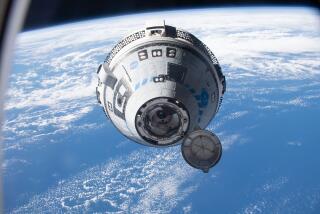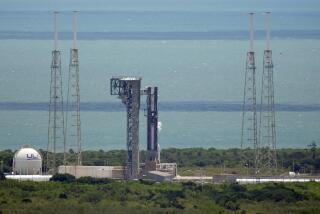Soviets Watch on Live TV as Cosmonauts Lift Off Toward Space Lab
- Share via
MOSCOW — The Soviet Union launched two cosmonauts into space today in the first manned space shot since the space shuttle Challenger exploded Jan. 28, killing all seven astronauts aboard.
Breaking with a tradition of secrecy, Soviet television carried apparently live coverage of Soyuz T-15’s liftoff at 4:33 a.m. PST.
The sleek red-and-white craft streaked into a slightly overcast sky above Baikonur Space Base in Kazakhstan, Soviet Central Asia, carrying commander Leonid Kizim and engineer Vladimir Solovev. The cosmonauts hold the endurance record for time spent in space: 237 days.
The official news agency Tass said they are to link up with the Soviet space laboratory, the Mir (Peace), in two days. The Mir was launched without a crew Feb. 20 and is designed as a permanent space platform with docking facilities for six spacecraft.
Footage From Inside Craft
Soviet television viewers could hear Kizim and Solovev reporting back to Earth 50 seconds after their craft blasted into the sky trailing orange flame.
In black-and-white footage shown on Soviet television, Kizim and Solovev could be seen strapped in their seats, with Kizim reading what appeared to be sheets of instructions. A television announcer said the pictures came live from inside the craft as it headed for orbit.
The television also continued to monitor radio conversation between ground control and the cosmonauts for about four minutes.
The Soviets announced Wednesday that Soviet television would carry the launch live on the nation’s main evening news program. The launch was also televised in the United States.
Break With Usual Secrecy
Disclosure of the names of the cosmonauts and the planned launch time marked a break with the usual secrecy applied to Soviet space missions that do not include foreigners.
The Soviet media gave no reason for televising the launch. However, it seemed in line with an effort by Soviet leader Mikhail S. Gorbachev to boost the Soviet Union’s image as a dynamic, confident power by contrasting today’s successful launch with the space shuttle Challenger disaster.
Soviet television showed dramatic footage of the Challenger explosion, and the official Soviet press has given extensive coverage to the U.S. investigation into the cause of the disaster.
Unlike the reusable U.S. shuttle, the Soviet space program relies on rockets that are used only once. The Soviet launchers do not use solid-fuel booster rockets like the one that ruptured during Challenger’s flight.
There was no announcement of how long the mission will last or whether additional crews will be sent up to the Mir in the near future.
More to Read
Sign up for Essential California
The most important California stories and recommendations in your inbox every morning.
You may occasionally receive promotional content from the Los Angeles Times.










